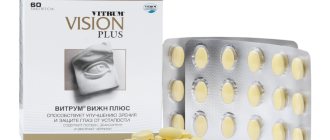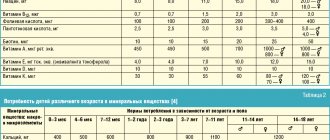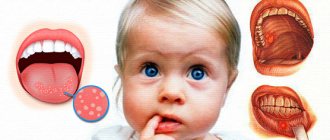Manufacturer: Access Business Group LLC (USA)
Active ingredients
- Not indicated. See instructions
Pharmacological action
- Not indicated. See instructions
- Composition of NUTRILIGHT Omega-3 Complex
- Indications for use of the drug NUTRILIGHT Omega-3 Complex
- Release form of the drug NUTRILIGHT Omega-3 Complex
- Contraindications to the use of the drug NUTRILIGHT Omega-3 Complex
- Method of administration and dosage of the drug NUTRILIGHT Omega-3 Complex
- Precautions when taking the drug NUTRILIGHT Omega-3 Complex
- Storage conditions for the drug NUTRILIGHT Omega-3 Complex
- Shelf life of the drug NUTRILIGHT Omega-3 Complex
Best before date
24 months
Vitamins with similar effects
- NewPlas apple-cinnamon (Powder for oral solution)
- NewPlas berry (Powder for oral solution)
- Dr. Theiss Elderberry + Vitamin C (Lozenges)
- Golden root tonic syrup (Syrup)
- Marine calcium for children with zinc (Oral tablets)
- NewPlas pineapple-banana (Powder for oral use)
- Progaine, chocolate (Powder for oral suspension)
- Retinol acetate (Oral tablets)
- Elfasept Phyto-Lor (Pastilles)
Description of the vitamin NUTRILIGHT Omega-3 Complex is intended for informational purposes only. Before starting to use any drug, it is recommended to consult a doctor and read the instructions for use. For more complete information, please refer to the manufacturer's instructions. Do not self-medicate; EUROLAB is not responsible for the consequences caused by the use of information posted on the portal. Any information on the project does not replace consultation with a specialist and cannot be a guarantee of the positive effect of the drug you use. The opinions of EUROLAB portal users may not coincide with the opinions of the site Administration.
Are you interested in vitamin NUTRILITE Omega-3 Complex? Do you want to know more detailed information or do you need a doctor's examination? Or do you need an inspection? You can make an appointment with a doctor - the Euro lab is always at your service! The best doctors will examine you, advise you, provide the necessary assistance and make a diagnosis. You can also call a doctor at home . Euro lab clinic is open for you around the clock.
Attention! The information presented in the vitamins and dietary supplements section is intended for informational purposes and should not be a basis for self-medication. Some of the drugs have a number of contraindications. Patients need to consult a specialist!
If you are interested in any other vitamins, vitamin-mineral complexes or dietary supplements, their descriptions and instructions for use, their analogues, information about the composition and form of release, indications for use and side effects, methods of use, dosages and contraindications, notes about the prescription of the drug for children, newborns and pregnant women, price and consumer reviews, or you have any other questions and suggestions - write to us, we will definitely try to help you.
NUTRILITE™ Omega-3 Complex (90 caps)
NUTRILITE™ Omega-3 Complex (90 caps)
Omega-3 acids are essential, or essential nutritional factors. In other words, they cannot be synthesized in the body and must be obtained in sufficient quantities from food throughout life. To maintain a healthy balance, your saturated to unsaturated fat intake should be kept within a 50/50 ratio.
The structure of nutrition at the present stage is such that the supply of essential fatty acids is extremely small. The basis of incoming fats are saturated fatty acids and cholesterol.
Unlike other dietary fats, which are used in our body mainly as energy suppliers, Omega-3 acids are structural components of cell membranes.
NUTRILITE™ Omega-3 Complex, which contains the optimal ratio of Omega-3 fatty acids (EPA - eicosapentaenoic acid and DHA - docosahexaenoic acid).
One capsule of NUTRILITE™ Omega-3 Complex provides approximately the same amount of Omega-3 fatty acids (EPA and DHA) as 28 g of salmon, tuna or sardines.
Omega-3 fatty acids are an essential component of every person's diet to ensure optimal functioning.
Omega-3 fatty acids belong to essential (irreplaceable) fatty acids, that is, they are not synthesized in the human body and must be supplied with food.
Normalizes fat metabolism.
Omega-3 fatty acids improve the functions of the nervous system, which increases concentration, improves memory, vision, and prevents the development of nervous and mental disorders.
Indispensable in comprehensive care for the condition of skin, nails and hair, promote high-quality renewal of skin cells, reduce dryness, peeling and redness.
NUTRILITE™ Omega-3 Complex does not contain gluten.
Does not contain lactose.
Does not contain artificial colors or flavors.
Omega-3 fatty acids support cardiovascular function.
FOOD SOURCES
Of all the variety of food products, Omega-3 acids are contained in sufficient quantities for the body only in the tissues of cold-water fish (tuna, sardines, salmon, mackerel, mackerel). Eicosapentaenoic and docosohexaenoic acids account for more than 25% of the total fatty acids in fish oil. Fish oil is unique in that it contains omega-3 PUFAs with a very long side chain, which is not found in vegetable oils. Other sources of Omega-3 acids include flaxseed oil, canola oil, soybean oil, and egg yolks.
Sufficient dietary intake of Omega-3 PUFAs is possible only with the daily inclusion of the above products in the diet. A deficiency occurs when fish is consumed less than 2 times a week.
POTENTIAL CONSUMERS
- people whose diet contains fish and some types of vegetable oils less than 1-2 times a week
- people on a low-fat diet
- people who use exclusively sunflower oils in their diet, as well as athletes during intense training.
METHOD OF APPLICATION AND DOSES
Adults and children over 14 years of age take 1 capsule 2 times a day with meals.
The duration of the course is 1 month.
NUTRILITE™ dietary supplements are not medicines.
It is recommended to consult a doctor before use.
The role of omega-3 unsaturated acids in the prevention and treatment of various diseases
Part 1
In a few years, we will celebrate the 100th anniversary of the discovery of essential fatty acids by biochemists Evans and Burr. In 1929, they discovered that mammals do not have enzymes that form double bonds at the n-3 and n-6 positions of the carbon chain of fatty acids. When the United States invaded Japan at the end of World War II, the United States stationed occupation troops in Japan. Many traditional Japanese foods have been replaced by items in the everyday American diet. Soon after, the Japanese began to suffer more often from colds associated with a lack of omega-3 fatty acids. Physical endurance also decreased, and more and more people began to suffer from chronic fatigue syndrome, depression, joint pain and constipation [1, 2].
Omega-3 (ω-3) is a group of unsaturated fatty acids that includes 11 polyunsaturated fatty acids (PUFAs), three of which (α-linoleic acid (ALA), eicosapentaenoic acid (EPA) and docosahexaenoic acid (DHA)) are irreplaceable, they are not reproduced in the body in the required volume, and their deficiency causes a variety of biochemical and physiological disorders. Although ω-3 PUFAs have been known as essential components for normal growth since the 1930s, awareness of their full importance for health has only come in the last few years. Recently, new technologies have introduced ethyl-esterified ω-3 PUFAs, such as E-EPA and combinations of E-EPA and E-DHA. They have attracted attention as being highly purified and more potent than traditional ω-3 PUFAs [3].
The beneficial effects on the cardiovascular system became well known in the 1970s, following research conducted by scientists. Subjects in the study consumed large amounts of seafood fats in order to identify their negative effects on health, but in fact, no cardiovascular disease was detected. High levels of ω-3 PUFAs, widely consumed by Eskimos, help reduce fat levels, which are the main causes of high blood pressure, atherosclerosis, heart attacks, strokes and many other diseases [4].
Large-scale epidemiological studies have shown a clear association between elevated blood lipids and mortality from cardiovascular disease. A direct relationship has been proven between the incidence and mortality rate from coronary heart disease (CHD) and the consumption of seafood containing large amounts of ω-3 PUFA. Thus, among residents of the Mediterranean, Greenland, and Japan, where fish and seafood containing ω-3 PUFAs are the main source of nutrition for the population, mortality from cardiovascular diseases is much lower than in other countries of Europe and America [5]. Omega-3 PUFAs, in addition to influencing lipid metabolism, have the ability to prevent the development of inflammation, blood clots, and heart rhythm disorders. To date, a large amount of evidence has been obtained regarding the effectiveness of the use of ω-3 PUFAs for the prevention and treatment of atherosclerosis and related cardiovascular diseases [6].
On September 8, 2004, the US Food and Drug Administration (FDA) officially recognized the effectiveness of ω-3 PUFAs and stated that “inconclusive but reasonable research suggests that consumption of EPA and DHA fatty acids acids reduces the risk of coronary heart disease." Currently, almost all official health authorities agree on the beneficial properties of ω-3 PUFAs, and not only those associated with cardiovascular diseases, but also many others. Later it turned out that ω-3 PUFAs, along with the hypolipidemic effect, have hypocoagulative, antiplatelet, anti-inflammatory and immunomodulatory effects [7]. In 2022, scientists from the Massachusetts General Hospital conducted an experiment in which it was noted that acids reduced the level of inflammation and oxidative stress caused by inhalation of polluted air by 50%.
Pharmacology of polyunsaturated fatty acids of the ω-3 class
Polyunsaturated fatty acids are divided into 4 classes: ω-3, ω-6, ω-7 and ω-9. This classification is based on the position of the first double bond relative to the carbon of the terminal methyl group. The main functions of PUFAs are their participation in the formation of phospholipids of cell membranes and the synthesis of eicosanoids (biologically active substances - tissue hormones): prostacyclins (PC), prostaglandins (PG), leukotrienes (LT) and thromboxanes (TC). These substances play an active role in regulating the functions of the entire body, especially the cardiovascular system. To understand the mechanism of action of PUFAs, two classes of polyunsaturated fatty acids are of practical interest to the clinician: ω-3 PUFAs and ω-6 PUFAs. The key representative of the ω-6 fatty acid class is arachidonic acid (AA). AA is part of the phospholipids of the cell membranes of platelets and endothelial cells. Free AA is rapidly metabolized, turning into prostaglandins and thromboxanes. There are two main pathways of AA metabolism: cyclooxygenase and lipoxygenase. The cyclooxygenase pathway of AA metabolism leads to the formation of prostaglandins and thromboxane A2, while the lipoxygenase pathway leads to the formation of leukotrienes. AK enters the body partly with food (vegetable oils), and is partly synthesized by the body, which ensures its constant presence in the human body. With insufficient intake of ω-3 PUFAs into the body, AA enters into the competitive synthesis of eicosanoids (Fig. 1).
The functional properties of eicosanoids synthesized from ω-6 (AA) and from ω-3 PUFAs are opposite (Fig. 2). Thus, prostacyclin 3 (PC3), formed from ω-3 PUFA, has a vasodilating effect and reduces blood pressure. Prostacyclin 2 (PC2), synthesized from ω-6, on the contrary, causes vasoconstriction. Various effects have also been established for thromboxanes. It has been shown that thromboxane 3 (TK3) is synthesized from ω-3 PUFA, which has a pronounced antiaggregation effect. Thromboxane 2 (TK2), synthesized from ω-6, on the contrary, activates platelet aggregation. Similar differences were revealed in the synthesis of LT. Series 5 leukotriene (LT5), synthesized from ω-3 PUFA, has a pronounced anti-inflammatory effect, while series 4 leukotriene (LT4), synthesized from ω-6 EPFA, does not affect inflammation processes, and in some cases even potentiates the development of inflammatory reactions [8, 9].
The competition between arachidonic acid and ω-3 PUFA at the cyclooxygenase-lipoxygenase level is manifested by modification of the spectrum of PG and LT:
- the production of prostaglandin E2 (PGE2) metabolites decreases;
- the level of thromboxane A2, a powerful vasoconstrictor and activator of platelet aggregation, decreases;
- the formation of LTV4, an inducer of inflammation, chemotaxis and adhesion of leukocytes, decreases;
- the plasma concentration of thromboxane A3, a weak vasoconstrictor and inducer of platelet aggregation, increases;
- the level of prostacyclin I3 (PGI3) increases, which, in the absence of a decrease in prostacyclin I2 (PGI2), leads to an increase in the concentration of total prostacyclin. PGI2 and PGI3 are active vasodilators and suppress platelet aggregation;
- the concentration of LTV5, a weak anti-inflammatory agent and chemotaxis factor, increases.
The lipid-lowering effect of ω-3 PUFAs is to suppress the synthesis of very low-density lipoproteins (VLDL) and low-density lipoproteins (LDL), improving their clearance and increasing bile excretion. In patients with lipid metabolism disorders, a positive effect is observed primarily in dyslipidoproteinemia types IIB and V. In such patients, the content of triglycerides, very low and low density lipoproteins decreases, and the level of high density lipoproteins increases.
Recently, many unflattering words have been heard about arachidonic acid. Apparently, it is necessary to give several arguments in defense of this substance. AA is an essential acid necessary for the functioning of the body. Its metabolites perform important regulatory functions, since in health conditions the most important are maintaining muscle tone, maintaining the integrity of blood vessels, and preventing bleeding from injuries. Among the AA metabolites, substances with broncho- and vasoconstrictor properties (PGF2α, class 4 LT) and inducers of blood cell aggregation (TCA2) predominate. And there are relatively few products with anti-inflammatory properties (PGI2, PGE) in the total volume of metabolites. In health conditions, when excessive vasoconstriction and bronchoconstriction are not provided, there is no need for excess vaso- and bronchodilators. Under conditions of illness, this nonspecific compensatory-adaptive reaction can transform into a pathological one. Overproduction of constrictor factors and thromboaggregation activators is already acquiring clinical significance and requires correction. Thus, in conditions of illness, a person is more in need of EPA metabolites, since substances with antispasmodic and platelet aggregation-inhibiting properties predominate among them.
Thus, eicosanoids synthesized from ω-3 PUFAs have anti-inflammatory and antithrombotic effects, and the ability to regulate vascular tone (as opposed to metabolites from ω-6 PUFAs).
Mechanisms of action of ω-3 PUFAs [10]:
- suppression of the synthesis of pro-inflammatory eicosanoids (prostaglandins of the 2nd series, leukotrienes of the 4th series) from AK;
- activation of the synthesis of anti-inflammatory eicosanoids (prostaglandins of the 3rd series, leukotrienes of the 5th series);
- decreased production of platelet aggregation factor, tumor necrosis factor and interleukin-1;
- suppression of the effect on erythrocyte growth factor (PDGF), reduction of erythrocyte aggregation, stimulation of relaxation of endothelial cells of the walls of blood vessels;
- normalization of lipid metabolism:
- decrease in the level of triglycerides and VLDL in the blood plasma;
- suppression of TG and apolipoprotein synthesis in the liver;
- activation of the removal of VLDL from the bloodstream by the liver and peripheral tissues;
- increased excretion of bile acids by the intestines;
- increased levels of high-density lipoproteins (HDL).
A wide range of mechanisms of action provides clinical and pharmacological effects of ω-3 PUFAs [11]:
- hypocholesterolemic;
- hypotriglyceridemic;
- antiatherogenic;
- antithrombogenic;
- vasodilating (hypotensive);
- anti-inflammatory;
- antiarrhythmic;
- cardioprotective.
Clinical applications of ω-3 PUFA
Primary and secondary prevention of cardiovascular diseases and ω-3 PUFAs
An important aspect is the effect of ω-3 PUFAs on thrombus formation and vasospasm. Due to competitive interaction with arachidonic acid, the production of thromboxane A2 decreases, which inhibits the processes of thrombogenesis. An increase in the level of tissue plasminogen activator helps to increase the fibrinolytic activity of the blood. A change in membrane fluidity helps to increase the plasticity of erythrocytes, reduce the aggregation ability of platelets and improve the rheological properties of blood. All of the above, as well as the anticoagulant effect, lead to a reduction in the risk of thrombosis.
The effect on blood vessels is manifested by an improvement in endothelial function, an increase in the release of endothelium-dependent relaxation factor, and an increase in the formation of vasodilatory prostacyclin. These effects were accompanied by a decrease in vascular muscle tone and suppression of the action of pressor neuropeptides.
A decrease in the production of pro-inflammatory leukotriene B4 under the influence of ω-3 PUFA promotes an anti-inflammatory effect, while changes in the activity of protein kinase C and the nature of the T- and B-cell response are observed. The anti-inflammatory effect is complemented by the influence of ω-3 PUFA on the secretion of lymphokines and cell proliferation, as well as inhibition of the formation of free radicals and lipid peroxidation.
The effect of ω-3 PUFA on lipid metabolism is manifested by a decrease in the synthesis of triglycerides and apolipoprotein B in the liver, and the removal of VLDL from the bloodstream. In addition, an indirect decrease in VLDL and an increase in HDL levels is achieved by increasing the excretion of bile acids.
Most of the beneficial effects of ω-3 PUFAs have been confirmed in randomized placebo-controlled trials in cardiac patients [12–15]: a 29% reduction in all deaths and a 27% reduction in fatal myocardial infarction; there was a reduction in cardiac mortality by 50%, non-fatal myocardial infarction by 48% (Indian Experiment of Infarct Survival). One of the authoritative clinical studies of the effectiveness of ω-3 with the largest sample of patients after myocardial infarction (11,324 people) is the European randomized placebo-controlled study - “GISSI-Prevenzione trial”, which showed a significant reduction in mortality in the group of patients who took 850 capsules mg ω-3 PUFA in combination with 300 mg vitamin E. Reduction in overall mortality by 20%, cardiovascular mortality and mortality from coronary artery disease - by 30% and 32%, respectively, non-fatal myocardial infarction and non-fatal cerebral stroke - by 16%. At the same time, the risk of sudden death decreased by 45% (GISSI Prevenzione).
The clinical effect of using ω-3 PUFAs was recorded after 3–4 months of treatment and increased with long-term use. A detailed analysis showed that the drug's benefits were mainly associated with a reduction in sudden deaths. In this regard, according to the conclusion of the European Society of Cardiology (ESC), ω-3 PUFAs have the most pronounced effect on the relative risk of death and sudden cardiac death among other drugs used in cardiological practice (including ACE inhibitors, statins, antiplatelet agents etc.) and not related to antiarrhythmics. Highly purified ω-3 PUFAs occupy a special niche among secondary prevention agents in post-infarction patients. They are the only drugs that directly affect the electrical instability of the myocardium. According to modern concepts, the mechanism of the antiarrhythmic action of ω-3 PUFAs consists of molecular-specific suppression of transmembrane channels, which leads to an extension of the inactive phase and an increase in threshold levels of depolarization in cardiomyocytes. This helps to stabilize the electrical activity of all contractile myocardial cells and, in turn, leads to a decrease in the tendency to form and spread ventricular tachycardia [16].
Due to their pronounced effect on sudden death, highly purified ω-3 PUFAs occupy a special niche among secondary prevention agents in post-infarction patients. The double-blind, placebo-controlled study, The Lyon Diet Heart Study, which included 4,233 subjects, was stopped due to the apparent effect: in subjects who received a diet containing increased amounts of PUFAs in the diet, the incidence of sudden coronary death decreased by 59% compared with with the control group [17].
It can be assumed that the beneficial effect of ω-3 PUFAs on the bioelectrical function of the myocardium can be realized not only in individuals with high coronary risk and in patients who have suffered a myocardial infarction. It should be assumed that this therapeutic effect can also be realized in other groups of patients with a high risk of sudden cardiac death and without coronary artery disease. These are primarily patients with dilatation of the heart without significant ischemia (dilated cardiomyopathy, heart defects with dilatation of cavities, etc.), as well as patients with reduced pumping function of the heart (EF < 40%) and manifestations of heart failure, who have electrical instability (extrasystole of high gradations, paroxysmal tachyarrhythmia).
The unique antiarrhythmic properties of ω-3 PUFAs make it advisable to use them for the prevention of sudden cardiac death in individuals without ischemic heart disease (in particular, with hypertrophic cardiomyopathy, alcoholic cardiomyopathy) and in general with arrhythmic syndrome without ischemic heart disease. In any case, research in this direction seems very promising. Recently, work has appeared in which ω-3 PUFAs were used to restore normal heart rate variability, since disturbances in its variability are predictors of paroxysmal tachycardias and sudden death [3].
The American Heart Association (AHA) in its recommendations for the primary prevention of cardiovascular disease (2003) indicates the need to eat fish (fatty varieties) at least 2 times a week or, as a convenient alternative, daily taking 500 mg ω-3 PUFA (in combination EPA + DHA).
The use of ω-3 PUFAs in the prevention and treatment of arterial hypertension and its complications
According to Russian researchers, the inclusion of ω-3 PUFAs in the diet of patients with arterial hypertension led to a significant decrease in both systolic and diastolic blood pressure within a month. The vasodilatory effect of PUFAs was especially pronounced in dyscirculatory encephalopathy caused by arterial hypertension. After a course of ω-3 PUFAs, a decrease in the “mosaic” nature of cerebral blood flow and normalization of blood circulation at the level of the microvasculature were noted [18].
Use of ω-3 PUFAs for the treatment of individuals with hypertriglyceridemia
The use of ω-3 PUFAs for the treatment of individuals with hypertriglyceridemia (isolated and/or combined) is described in the literature [19]. As is known, hypertriglyceridemia (more than 2.3 mmol/l) is an independent risk factor for the development of coronary artery disease. The phenomenon of hypertriglyceridemia often accompanies type 2 diabetes mellitus, obesity, metabolic syndrome, and some dyslipidemias, including chronic kidney disease. Considering the favorable spectrum of influence of ω-3 PUFAs on lipid metabolism, we can expect a positive effect of their use in this category of patients in relation to all manifestations of atherosclerosis - coronary, cerebral, peripheral. A possible explanation for the increase in HDL levels under the influence of ω-3 PUFAs is considered to be a decrease in the formation of large VLDL under the influence of PUFAs and an increase in less atherogenic small lipoproteins, which are more quickly converted to LDL, as well as an increase in the excretion of sterols and bile acids in the feces. It is also assumed that PUFAs modify HDL, affecting the fluidity of their lipids and the movement of cholesterol into these particles, as a result of which the removal of cholesterol from the cell is facilitated and an antiatherogenic effect is realized [20].
Possible mechanisms of hypotriglyceridemic action may be a decrease (by more than 50%) in the synthesis of chylomicrons in the intestine, facilitating the contact of unsaturated chylomicrons with lipoprotein lipase, and a decrease in TG synthesis in the liver. It has also been established that ω-3 PUFAs bind to the transcription factors of the genes PPAR (peroxisome proliferato-activated receptor), which activates the oxidation of fatty acids, and SREBP (sterol regulatory element binding protein), which regulates the pathways of TG synthesis, activating them, reducing synthesis and increasing catabolism fatty acids. As a result, the synthesis of TG and the release of VLDL from the liver into the bloodstream decreases [21, 22].
There are already more than 70 placebo-controlled studies that used a combination of EPA and DHA in amounts of 1 to 7 g per day over a long period (2 weeks or more). The lipid-lowering effect was demonstrated in 25% of patients with normal blood lipid levels and in 28% of patients with hyperlipidemia. The 2003 American Heart Association guidelines emphasize 1 g ω-3 PUFA capsules or 2–4 g fish oil [23].
Metabolic syndrome
Metabolic syndrome is characterized by the presence of three or more risk factors, such as abdominal obesity, increased blood pressure, insulin resistance, increased TG levels in the blood, and decreased glucose tolerance. Clinical studies have shown that in metabolic syndrome, ω-3 PUFA (EPA + DHA) supplementation helps reduce insulin resistance, total cholesterol (TC) levels, and the TC/HDL ratio. In addition, ω-3 PUFAs (EPA + DHA) reduce blood pressure in patients with arterial hypertension (BP level > 140/90 mm Hg). The lipid-lowering effect of ω-3 PUFAs manifests itself mainly in a decrease in TG levels, while the cholesterol concentration changes slightly. However, there is clinical evidence of a slight increase in LDL cholesterol by 1–3% when taking ω-3 PUFAs. No significant effect of ω-3 PUFAs on cholesterol levels was found, therefore, for patients with mixed hyperlipidemia, it is advisable to carry out combination therapy, combining ω-3 PUFAs with statins. Thus, the administration of ω-3 PUFAs to patients with metabolic syndrome has a positive clinical effect, which is manifested in a decrease in glucose tolerance and insulin resistance, normalization of TG levels, an increase in HDL levels, and a decrease in blood pressure. Another important factor in the prevention of cardiovascular diseases in patients with metabolic syndrome is the ability of ω-3 PUFAs to reduce the level of C-reactive protein and pro-inflammatory eicosanoids, thereby reducing the severity of inflammatory reactions [24].
Prevention and treatment of diabetes mellitus
Due to the fact that ω-3 PUFAs increase the fluidity of cell membranes, thereby increasing tissue sensitivity to insulin, and are a substrate for the production of prostaglandins, which increase the number of insulin receptors, they are used in the prevention and treatment of both type 1 and type 2 diabetes mellitus types. It has been proven that consumption of foods rich in ω-3 PUFAs (in particular, cod liver) in the first year of life significantly reduces the risk of developing the disease (relative risk 0.74). These data were obtained based on a study of 545 children suffering from type 1 diabetes mellitus; 1668 healthy children formed the control group [25].
Bronchial asthma and chronic obstructive pulmonary diseases
In bronchial asthma and chronic obstructive pulmonary diseases (COPD), ω-3 PUFAs, due to their competitive relationship with arachidonic acid (increased production of prostaglandins, inhibition of the activity of pro-inflammatory leukotrienes), have a bronchodilator effect, reduce swelling of the mucous membrane, promote thinning and better discharge of sputum. The inclusion of ω-3 PUFAs in the complex therapy of patients with COPD provided a more pronounced and more stable clinical effect, especially in children, and helped reduce the load of corticosteroid and adrenomimetic drugs [26].
Read the end of the article in the next issue.
E. Yu. Plotnikova1, Doctor of Medical Sciences, Professor M. N. Sinkova, Candidate of Medical Sciences L. K. Isakov, Candidate of Medical Sciences
Federal State Budgetary Educational Institution of Higher Education Kemerovo State Medical University, Ministry of Health of the Russian Federation, Kemerovo
1 Contact information
The role of omega-3 unsaturated acids in the prevention and treatment of various diseases (part 1) / E. Yu. Plotnikova, M. N. Sinkova, L. K. Isakov For citation: Attending physician No. 7/2018; Page numbers in the issue: 63-67 Tags: polyunsaturated lipids, ratio, nutrition, cardiovascular diseases, prevention





